This generation of graphics cards has been incredibly exciting, with hot competition from AMD and Nvidia throughout the performance spectrum. That’s true at the top end too, where Nvidia’s flagship cards often just pip ahead of AMD’s best, even if it’s not by much. But Nvidia is looking to change that with a new god-tier graphics card: the RTX 3090 Ti.
This new GPU will feature the fully unlocked GA102 GPU, with more CUDA cores, higher clock speeds, and faster memory than even the already super-powerful RTX 3090.
Although it’s probably going to lead to some exceptionally high power and thermal demands, the RTX 3090 Ti is set to become the new king of GPUs when it launches in the very near future.
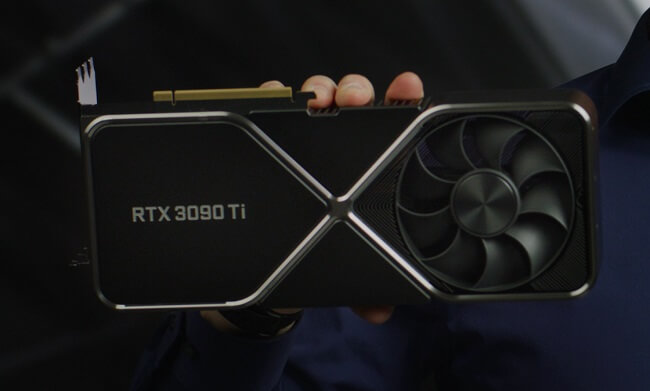
RTX 3090 Ti Specs
| RTX 3090 Ti | RTX 3090 | RTX 3080 Ti | RTX 3080 | |
| GPU | GA102 | GA102 | GA102 | GA102 |
| Process node | 8nm Samsung | 8nm Samsung | 8nm Samsung | 8nm Samsung |
| Interface | PCIExpress 5.0 (Rumour) | PCIExpress 4.0 | PCIExpress 4.0 | PCIExpress 4.0 |
| CUDA Cores | 10752 | 10496 | 10240 | 8704 |
| RT Cores | 84 | 82 | 80 | 68 |
| Tensor Cores | 336 | 328 | 320 | 272 |
| Base Clock | 1,560MHz | 1,395MHz | 1,365MHz | 1,440MHz |
| Boost Clock | 1,860MHz | 1,696MHz | 1,665MHz | 1,710MHz |
| Memory | 24GB GDDR6X | 24GB GDDR6X | 12GB GDDR6X | 10GB GDDR6X |
| Memory speed | 21 Gbps | 19.5 Gbps | 19 Gbps | 19 Gbps |
| Memory bus | 384-bit | 384-bit | 384-bit | 320-bit |
| Bandwidth | 1,008 GBps | 936 GBps | 912 GBps | 760 GBps |
| TDP | 450W | 350W | 280W | 250W |
Where does it stand amongst the others?
The raw specifications of the RTX 3090 Ti show the key areas where it differentiates itself from the other high-end GPUs in the RTX 3000 series. Although the RTX 3080 falls noticeably behind in terms of memory and CUDA core numbers, the differences between the rest of the cards are far less stark.
The RTX 3090 Ti builds upon the class-leading specifications of the RTX 3090 by adding an extra 256 CUDA cores – an increase of 2.5%. It also has minuscule increases in the number of RT cores and Tensor Cores, which are unlikely to meaningfully affect ray tracing or deep learning super sampling (DLSS) performance.
Where the RTX 3090 Ti does stand apart, however, is its clock speeds and memory performance.
Where previously the RTX 3080 held the highest base and boost clocks of these top cards, the RTX 3090 Ti manages to go significantly higher, despite its greater number of CUDA cores. Its base clock rests at a speedy 1,560MHz, but when loaded, it can boost to a blistering 1,860MHz. This unlocks what should be a notable increase in overall performance in general rasterization, and in AAA games featuring ray tracing.
This card is the first to feature 21Gbps GDDR6X memory, too, pushing the overall bandwidth over 1,000 GBps for the first time.
All of that does come at a price though: power and thermals.
How much power are we talking?
The entire RTX 3000 generation has been power-hungry and hot under the cooler, but the RTX 3090 Ti pushes that to new heights. The TDP is rated at 450W, with Nvidia rating a 1,000W PSU as a minimum.
As with most high-end RTX cards though, we’d recommend you go higher than that if possible, as these cards can spike with much higher power demands at times. A 1,200W quality power supply would be a solid companion for a card like this.
One rumoured specification upgrade from the RTX 3090 is that the RTX 3090 Ti might be the first graphics card to feature a PCIExpress 5.0 interface. That won’t have a dramatic effect on performance, as the PCIE 4.0 x16 slots are nowhere near saturated by current GPUs, but it could mean greater power delivery through the motherboard.
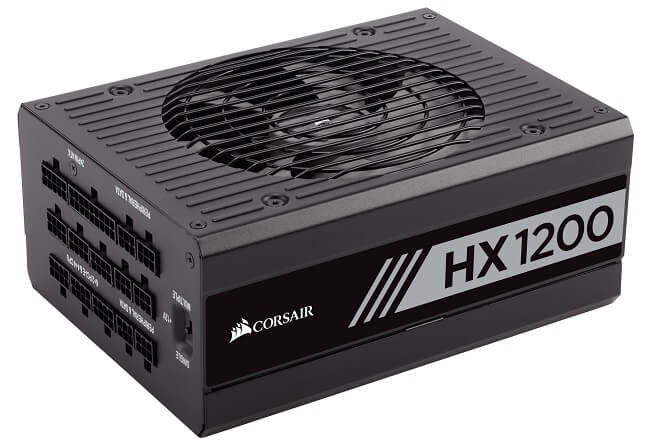
What is the RTX 3090 Ti’s release date?
At the time of writing, the RTX 3090 Ti hasn’t been given an official release date, with Nvidia promising more information about the card at the end of January. That doesn’t mean there hasn’t been some hot speculation about the graphics card and when it might debut, though.
The earliest rumours about the 3090 Ti suggested it wouldn’t debut until late Spring 2022 – somewhere around April, most likely. Others suggested we might not see it until Summer 2022, however, which would make its January debut more of a headline grabber than a real reveal of a full product. Especially since Nvidia’s next-generation RTX 4000 Lovelace GPUs are rumoured to launch sometime in the Autumn of this year.
More recent rumours pointed to an earlier release, closer to the end of January, but those may now have been scuppered as there have been rumours of problems with the RTX 3090 Ti’s BIOS and some issues with the hardware (possibly the cutting-edge memory). That’s led to a pause placed on production at both Nvidia and its add-in board partners which produce the aftermarket alternative cards.
With that in mind, February 2022 is the absolute earliest this card is likely to appear, with it probably set to land in any real numbers later in the Spring, as the earlier rumours suggested.
Real world performance – how fast is the 3090 Ti, really?
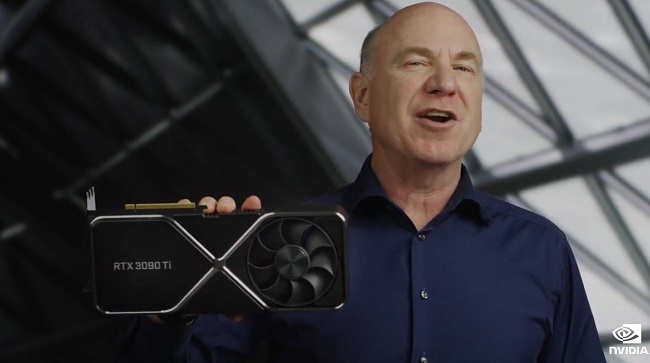
Until the card is launched and in the hands of third-party reviewers who are less likely to put a positive spin on things, the actual raw performance of the RTX 3090 Ti will remain unknown. However, thanks to some of the first party numbers and results Nvidia has released, and the updated specifications, we can extrapolate what the card might perform like when we do finally get to see it in action.
Nvidia detailed the RTX 3090 Ti’s performance in “Terraflops.” While that doesn’t tell us exactly what kind of frame rates we can expect at certain resolutions with different settings enabled, it does let us do a direct comparison with some of Nvidia’s other cards.
The shader performance or the traditional rendering power of the RTX 3090 Ti is said to be 40 TFLOPs. That’s 4 TFLOPs more than the RTX 3090’s 36. More stark, however, is its ray tracing performance, which is said to reach 78 TFLOPs, versus the RTX 3090’s 69 TFLOPs.
That 11 and 13% increase in TFLOPs performance, respectively, comes from the small bump in CUDA cores, the more-significant increase in boost clock speed, and the 8% increase in memory bandwidth. The extra couple of RT cores likely help the ray tracing performance a little, but there can’t be much in that.
Nvidia’s suggestion with such numbers is that we can expect the RTX 3090 Ti to be between 10 and 15% faster than Nvidia’s RTX 3090 Founders Edition, depending on the game and settings enabled; that’s about what we saw with the release of the RTX 3080 Ti.
If Nvidia’s TFLOPs numbers bear any relation to real-world performance numbers, the RTX 3090 Ti will likely show the greatest performance advantage in games where heavy ray tracing is enabled.
Power and thermals
One major consideration to make with any top-tier graphics card is its power and thermal requirements.
Big, powerful graphics cards need lots of power to run at their full potential – and to even be stable, in some cases. All that power means they put out a lot of heat too, which means you’ll need to factor that into the type of chassis you’re fitting it into and consider whether it will affect the cooling of your other components.
All Nvidia’s RTX 3000 series graphics cards have raised the bar for what’s expected from power demands, with the RTX 3090 demanding 350W from the recommended 750W PSU – and in the real world, often more at micro-second spikes.
The RTX 3090 Ti, however, goes a lot further. Nvidia claims it will need as much as 450W sustained power to run effectively, recommending at least a 1,000W power supply to keep it running stable.
To make sure it stays that way, it’s probably better to opt for an even-more capable PSU than that. A 1,200W unit would give you some wiggle room, but make sure that any power supply you match with a card like this, that you use a quality power supply. Not only will that make sure it gets clean, stable power for peak performance, but the last thing you want to do is put a dodgy, cut-price PSU with such an expensive card.
Strong Cooling Needed
As for thermals, 450W is a lot of heat to dump out into your case, so making sure you have a strong intake and exhaust fan system will be of paramount importance to keep the card running relatively cool and quiet, helping to avoid throttling.
It’s also likely that the RTX 3090 Ti will have at least a little overclocking headroom too, so making sure your system cooling is strong might give you some room to play with if that’s something you’re interested in.
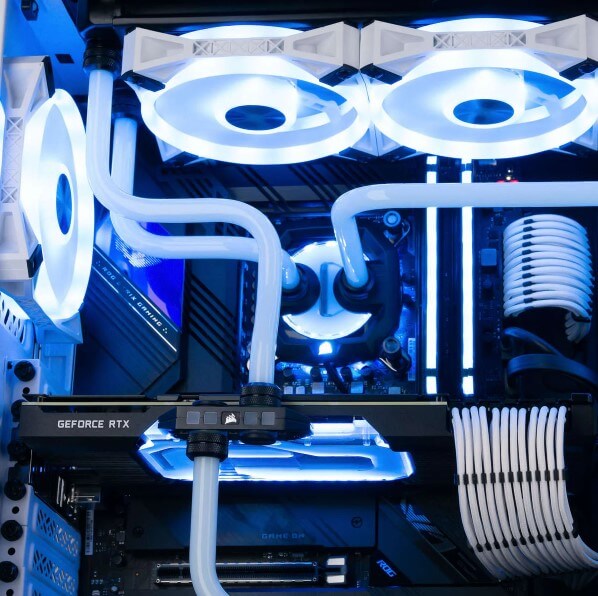
How much will the RTX 3090 Ti cost?
This is the big question that has yet to be officially answered by Nvidia or any of its board partners.
As the absolute king of Nvidia’s GPU hill, the RTX 3090 Ti will be almost certainly the most expensive card available this graphics generation, and with the RTX 3090’s original retail price sitting at around £1,500, that would make the RTX 3090 Ti likely to edge close to, if not match £2,000.
Unfortunately, that’s just the first piece of the puzzle. Ongoing GPU shortages mean that prices of individual graphics cards tend to far exceed their original retail value, unless you get extremely lucky and beat the scalpers. That likely means that the RTX 3090 Ti could be £2,500, or even over £3,000 per card once early stock is depleted.
The best way to buy a new GPU in 2022 is through a full system upgrade.
System builders like Chillblast aren’t immune to graphics card price hikes, but we are insulated from them and continue to provide a wide range of new-generation graphics cards at fair and affordable prices. When new gaming PCs with RTX 3090 Ti GPUs become available, you can rest assured they’ll be as economical as we can make them, while offering the absolute best gaming performance money can buy.
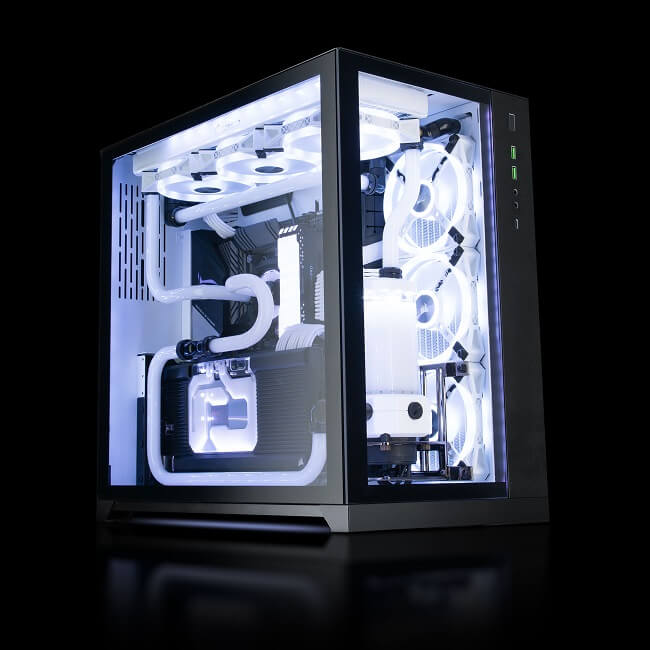
This Chillblast Fusion Kraken Ultimate Gaming PC is available with an RTX 3090 now, but look out for an RTX 3090 Ti version in the near future.
Is the RTX 3090 Ti worth it?
This question can only really be answered by you, the person considering buying it. However, there are some important factors to consider with the RTX 3090 Ti and its alternative graphics cards.
The most important aspect is budget, and if the RTX 3090 Ti stretches yours to uncomfortable levels, it’s probably not worth considering – especially when there are several other high-end graphics card options in both the RTX 3000 and AMD Radeon RX 6000 generations worth considering as well.
However, if the RTX 3090 Ti is a card you can comfortably afford, then it does hold a lot of potential.
When released, it will absolutely be the fastest gaming graphics card ever made, delivering untold performance in 4K and even 8K resolution in some games. It will offer the smoothest ray tracing possible in early 2022, and will likely remain the most impressive GPU for many months to come.
It won’t be that much faster than the RTX 3090 and RTX 3080 Ti, though.
Both of those cards, and even the RTX 3080 to a lesser extent, will continue to offer near top-tier gaming performance whatever resolution and settings you want to play at, and whatever games you play. If you want to enjoy the latest AAA games at the highest possible details and frame rates, or if you want to play virtual reality games at superscaled resolutions, then you need every bit of performance you can get. But if you don’t mind sacrificing a few frames, or a couple of detail settings, then the RTX 3090 Ti isn’t a must buy.
Just a very, very ‘nice-to-have’.
Get In Touch
For more help with deciding which graphics card is right for your next gaming PC, give Chillblast a call to speak to one of our highly experienced system builders. They’ll walk you through all of the options available for your dream gaming PC, from graphics cards, to processors, high-speed storage, and even overclocking. Whatever your needs and budget, they’ll help you build a gaming PC that will be fast and responsive for years to come, letting you enjoy your favourite games just how you like them.






